A valuable volume to narrate the Cathedral of San Martino in Lucca: entitled San Martino a Lucca. Stories of the Cathedral the book published by PubliEd (297 pages, 49 euros, ISBN 9788896527597), edited by Paolo Bertoncini Sabatini, architect and professor of History of Architecture at theUniversity of Pisa, with the rich photographic apparatus executed for the occasion by photographer Andrea Vierucci. This is an extensive volume that aims to deepen the knowledge of Lucca’s cathedral in the light of the latest knowledge, telling not so much the “history” of the cathedral, but the “stories” of the great building of worship: and discovering the “stories” means, yes, following the architectural development of the building and knowing its millenary history, but it also means fixing our gaze on some chapters to which publications of this type normally reserve little space. Here, then, in the book we see a succession of lunges, for example, on the portals of San Martino, on the organization of the building site, on the role of the great Nicola Pisano, or even on the humanistic “ratio” and the Christian “pulchritudo” that guided the development of the building and its decoration.
There are eight essays that make up the publication, all entrusted to scholars of recognized reputation: the introductory contribution bears the signature of the current director of the Florence Cathedral Museum, Timothy Verdon, followed by essays on the vicissitudes of the cathedral from the 11th to the 16th century (by Raffaele Savigni), on portals (by Aurora Corio), on Nicola Pisano in San Martino (by Clario Di Fabio), on the corpus of inscriptions in the cathedral (by Luigi Bravi), on patronages and burials in San Martino between the 14th and 15th centuries (by Annamaria Giusti), on the correspondence between development and furnishings, and on the 15th-century reinterpretation of the interiors by Matteo Civitali (by Paolo Bertoncini Sabatini) and his paintings (by Luigi Ficacci). A handy index of names and an up-to-date bibliography close the proceedings.
The book comes at the end of a long, as well as fundamental, 20-year restoration campaign: it is a “journey,” Bertoncini Sabatini writes in the book’s introduction, “designed to touch on some sensitive points of the building, its history and its nature.” An unfolding that, though articulated, makes no claim to completeness, the editor explains, “impossible to achieve and never invoked,” but aims to account for “the mosaic of stories, of values from which to trace the idea of a confidential core, a center where the vision coagulates. The volume’s title reflects the warp of this collection of readings designed to flesh out a historiographical design that brings together specialized insights. The cathedral of Lucca as a whole certainly demands even more than an extended and articulated series of in-depth and rigorous essays, an expression of the different possibilities of reading the monument: many critical knots remain to be addressed and investigated, research and insights to be developed, half-opened doors waiting to be thrown wide open, but the sense of these pages is to open up to a kind of inner view, an inner sense that should be proper and inescapable of historiography. The words and images that keep memory alive transport us into stories full of echoes and memories. This is why we are here: to rediscover a part of ourselves, including through the temple we are about to explore, a shining beacon of our civilization, a sacred place not only for people of faith, but for all our fellow human beings.”
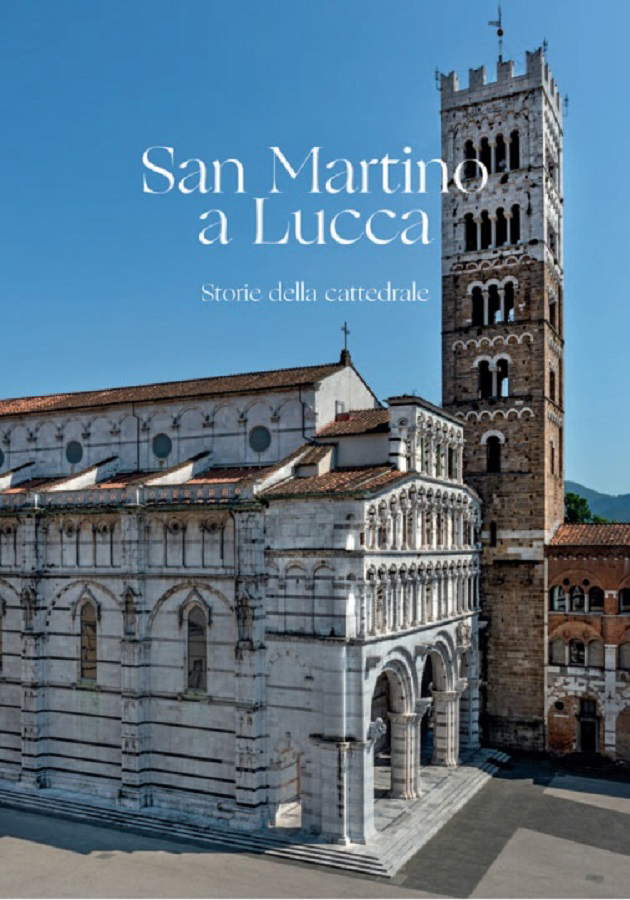 |
| The cover of the book |
A history, that of the cathedral of Lucca, that has very ancient origins: the first documented period, Verdon recalls, goes back to the end of the 8th century, when the Holy Face, the crucifix that arrived in Luni from the Holy Land, then brought to Lucca, and believed to be miraculous, made its entrance into the cathedral. It was, however, in 1060, under Bishop Anselm of Baggio (later to become, in 1061, Pope Alexander II), that the great renovation took place that was part of the architectural policy of the reforming popes of the 11th and 12th centuries, and it was in 1070 that the new cathedral in Lucca was consecrated by Alexander II himself. For St. Martin’s it was a new beginning, the beginning of a very long and complex life that would make the cathedral one of the most complex buildings in Tuscany and Italy not only for its artistic merit, but also for theauctoritas it was accorded and for the functions it performed (again Verdon recalls how, already between the 11th and 12th centuries, a court, a hospital, an infirmary, cloisters and vegetable gardens sprang up around the cathedral). Verdon’s essay also focuses on the “administrative” history of the church, with lengthy passages on the ways in which the cathedral was managed over the centuries, as well as on the role of the fabbriceria di San Martino, its lay component, and the changes in its leadership, also in relation to different historical moments, until reaching the Renaissance and in particular the period around the middle of the 15th century, when the cathedral took on much of its current appearance and was enriched with works that are still iconic today (two above all: Ilaria del Carretto’s monument, a masterpiece by Jacopo della Quercia, and Matteo Civitali’s octagonal temple).
The events concerning the development of the cathedral are further explored in Raffaele Savigni’s essay, who reminds us that at the moment the origins of the church are still not well known: San Martino is first mentioned as an episcopal see in 724, then in 767 a schola capitolare is attested, but we do not know the date of construction of the building, nor what form it took. Reconstruction in 1060 became necessary because of the poor condition of the building, which also had unsafe roofs, as well as, as Clara Baracchini and Antonino Caleca wrote in the 1970s, “in function of a new liturgy that emphasized the community of canons and people huddled around the bishop.” Interventions, however, followed one another for centuries, so much so that in the 14th century there were other major renovations: in 1308 the construction of new tribunes began, new altars were raised, and then again new chapels were built (such as the one dedicated to St. Benedict, consecrated in 1345). The new layout, the final one, dates from 1372, while in the following century the cathedral underwent a radical interior renovation designed by Matteo Civitali: the building we see today is thus the result of this complex layering, which would be followed by other interventions (e.g. Vasari’s altars) in the following centuries.
And as the architectural development of the church proceeded, so did its decoration: on aspects related to the latter focus, as anticipated, the essays by Aurora Corio and Clario Di Fabio. The former deals with the portals of the cathedral, which represents a novelty for studies in that it first analyzes a hitherto little-emphasized aspect, namely the monopoly of Como artists (coming, in particular, from the areas around the val d’Intelvi and Lake Lugano) in Lucca in the late 12th cent, which nevertheless did not result, Corio writes, “in an enclave of Po Valley culture impermeable to the influences of local sculpture and architecture, but rather, as one would expect, in an osmotic and receptive network, an incubator of new linguistic syntheses.” Syntheses founded on the “expanded and simplified” volumes of Guidetto’s sculpture, on architectural decoration and paratactic description “which almost entirely sacrifice narrative,” and which would also characterize the production of the artists of the next generation (those active in the first decades of the thirteenth century). Thus, workers in Lucca were endowed with artistic skills but also with abilities concerning the design, management and organization of construction sites: Corio points to Lucca’s as an exceptional case, where the foremen (such as the “mestro Lombardo” who was awarded the position of senior worker by the Opera del Duomo of Lucca) had not only technical roles, but also managerial roles. It was at this stage that the facade of the cathedral, with its portals, was born (although the decoration would only come to completion later, with the intervention of Nicola Pisano, between about 1257 and 1260). The essay dwells at length on the portals and its reliefs, the subject of a long attributive debate. The hands can be summarized as follows: the reliefs between the portals are attributed to the Master of San Martino, those of the central portal to the young Guido Bigarelli (one of the major sculptors of early 13th-century Tuscany: the lintel of the central portal is his first sculptural essay in Lucca), and then again those of the right portal are by an anonymous conventionally referred to as Master of San Regolo, while the lunette of the central portal and the symbols of the Evangelists are by critics alternately attributed to the same Master of San Regolo or to another anonymous Master of the Maiestas Domini (the distinctions are difficult to recognize due to the fact that the sites, in the 13th century, operated in an extremely organic manner and according to a precise unity of style, which is why it is often very complex to recognize different personalities).
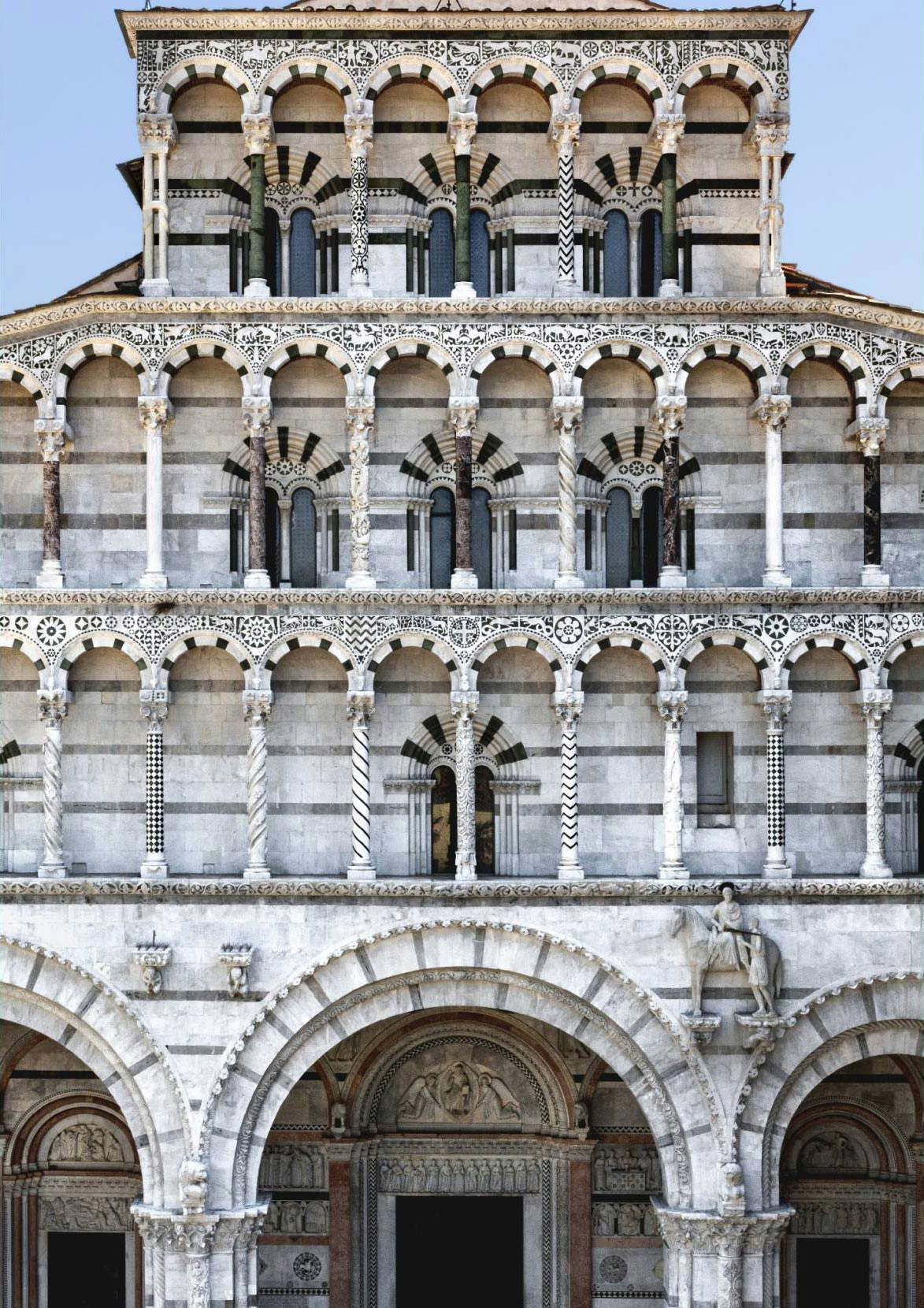 |
| The facade of San Martino |
 |
| The Cathedral of Lucca |
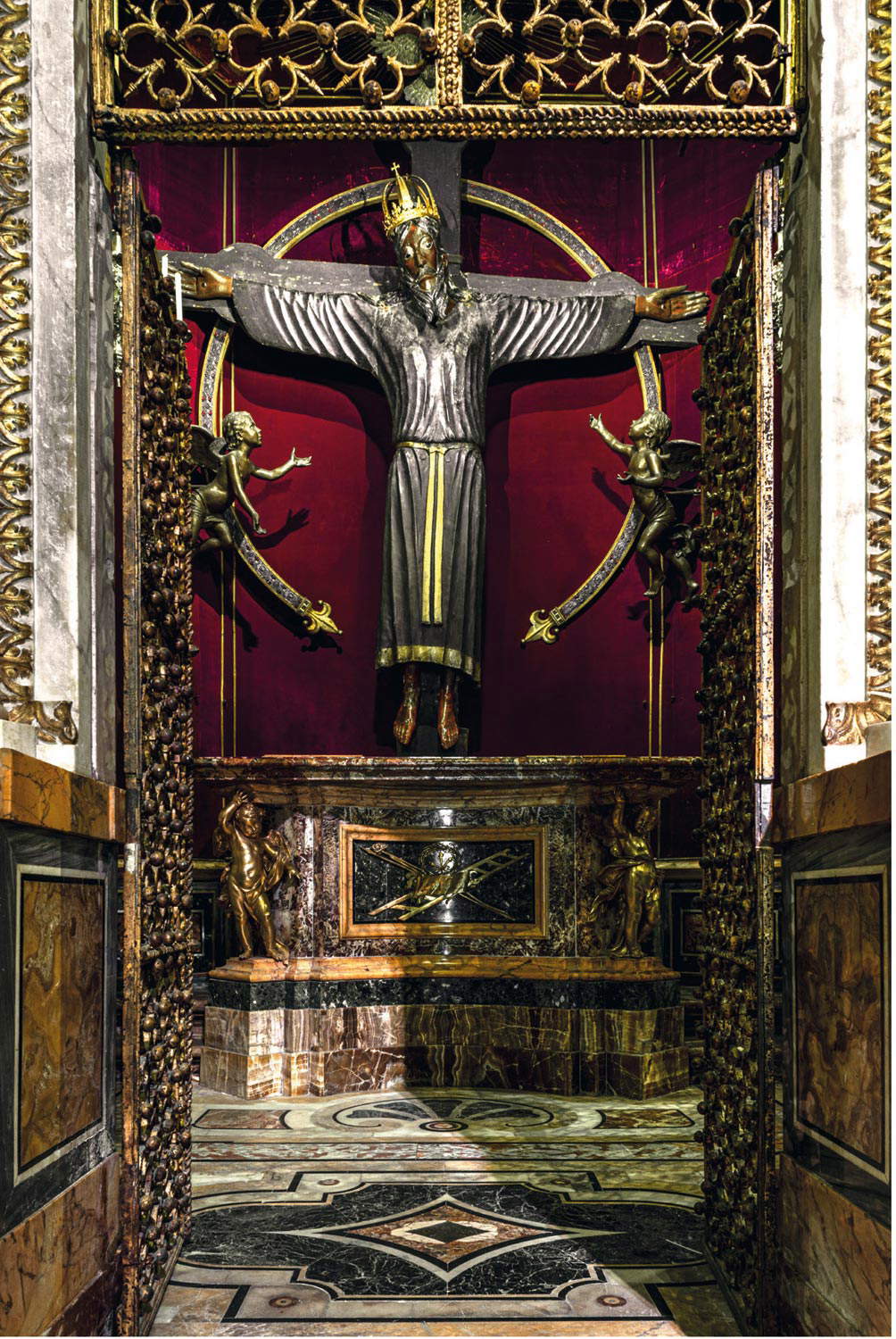 |
| The Holy Face |
 |
| Detail of the facade |
Corio argues that in Bigarelli’s portals are to be recognized the first steps of the renewal in the Gothic sense of sculpture in Tuscany, which took its first steps just before Nicola Pisano. In listing the reliefs of the portals, no mention has been made of the left one, since the lunette and architrave accommodate here one of Nicola Pisano’s masterpieces: the Deposition (in the lunette), and the Stories of the Infancy of Christ (in the architrave), reliefs that were also restored as part of the recent campaign. Clario Di Fabio, in his essay, reconstructs the history of these reliefs: Nicola Pisano’s relations with Lucca go back as far as 1258, a time when the three portals of the facade of the cathedral had already been built, although some of them remained to be decorated. By 1257 Guido Bigarelli had passed away, and someone was needed to succeed him in completing the decoration of the portals: Nicola Pisano was hired under a contract that today we would call “project-based,” that is, Di Fabio specifies, “within given limits (respecting, that is, the predetermined spaces and architectural forms), for a defined purpose (dealing with the ’pure figure’ parts) and then returned to where he had come without aspiring to open a workshop in Lucca, upsetting its corporate balance.” The artist of Apulian origin was considered ideal for the purpose, and the latest analysis of the work was able to confirm without a doubt that Nicola worked on a layout prepared by those who had preceded him (“the realization and assembly of jambs, colonnettes, capital bands and archivolts are due to the guidesca maestranza,” “the presence of a figured architrave and lunette were already planned ; resembling those of the right portal”; “prepared at that stage had also been the foliate traverse superimposed on the architrave”; the Deposition “was inserted into the empty lunette already prepared [...] by raising it to the level of the niche and then moving it into it,” the latter operation causing heavy damage to the lunette itself).
Further consideration deserves to be given to the workmanship of Nicola’s work: probably the Opera del Duomo of Lucca bought the marble directly from the quarry in Carrara and had it worked there. Nicola would then have worked on it in Pisa and finished the work directly in Lucca, when it was already to be ready for assembly: the idea that the artist worked on it in Pisa, away from the Lucca site, is supported by the fact that the stylistic similarities with the figures in the pulpit of the Pisa Baptistery, made in the same years, are stylistically identical. Again, for Di Fabio the lunette is unique “in terms of the relationship between the images and the shape of the figurative field in which they are inserted.” according to the scholar, "there are no comparisons in Italy for the way in which these figures, not integral with the wall behind, saturate the whole semicircular hollow of the archway, between the architrave frame and archivolts; the sculptor subjects himself to a draconian loi du cadre that stimulates him to launch a figurative formula unheard of south of the Alps but not in the French or Germanic area: a plenitudo figurarum (as one might call it) that has parallels, for example, in the portal of the south transept in Strasbourg (circa 1220).“ In the Lucchese lunette, in essence, bodies are the protagonists: ”nothing there is that is not humanity, gesture, attitude, gaze and that does not claim to attract the eye and the personal involvement of the viewer." And recent restoration has given the lunette the best possible conditions of legibility.
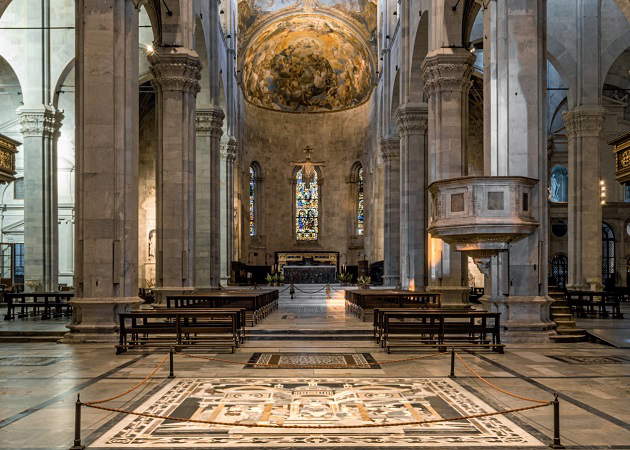 |
| The interior of the cathedral |
 |
| The small temple by Matteo Civitali |
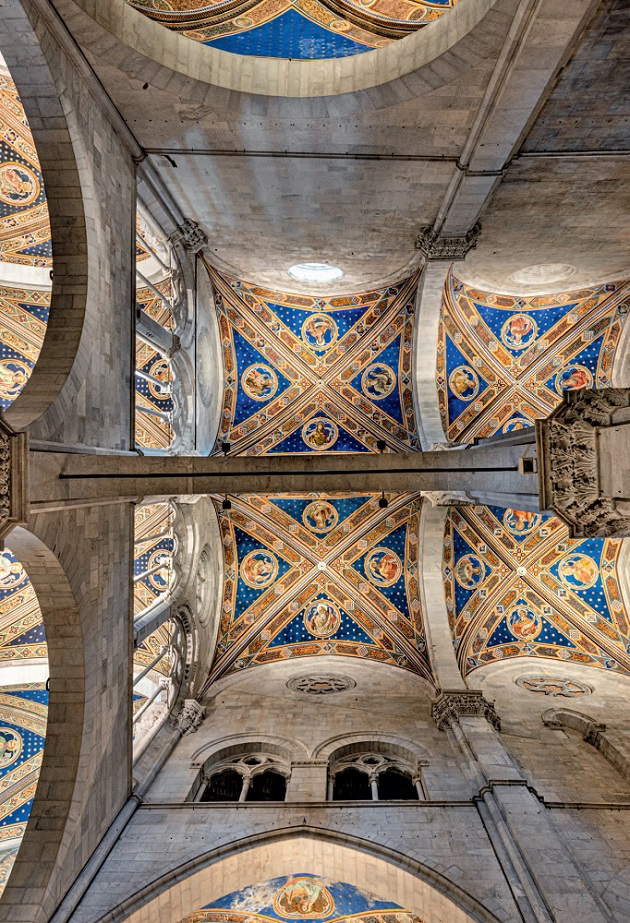 |
| The frescoed vaults in the 19th century |
The next contribution by Luigi Bravi reviews all the epigraphs of the cathedral, from which “a series of data are inferred that, in different ways, were produced with the precise purpose of monumentalizing its memory”: burials, interventions on the architecture, reporting of events related to cults and whatnot. The contribution contains an accurate census of the inscriptions: for each one the location, transcription, translation into Italian if written in another language are given, concluding with an index of the names of the people to whom the epigraphs refer. Many of the inscriptions accompany burials, and it is on this chapter, and in particular on patronages and burials in San Martino between the fourteenth and fifteenth centuries, that Annamaria Giusti’s essay focuses. Studying patronages and burials of the cathedral in this period also means delving into aspects of Lucca’s society of the time: which were the city’s most illustrious families, how they positioned themselves, how vital was Lucca’s economic fabric, what religious views informed the mentality of the time.
This leads to the penultimate essay, in which the volume’s editor, Paolo Bertoncini Sabatini, traces some of the architectural events of the cathedral of San Martino, addressing them from the point of view of the continuity between building and interior. The space and structure of the cathedral, the scholar writes, "recall a balanced, since harmonious and measurable, combination of clear and comparable volumetries, of intersections of walls and membranes linked to the geometric logic of the right angle and the plane; at the same time, the whole templar machine appears innervated by simple proportional ratios in the name of a ratio memory of Classicism, whereby geometry and number embody a new and modern beauty." At the center of Bertoncini’s study are the relationships between the measurements of the elements of the structure: spatial coordinates that are already fixed, with a proto-humanistic attitude that germinated from the medieval classicism that determined the choices of the designers, between the late thirteenth and early fourteenth centuries, in the same turn of the century in which the cathedral of Santa Maria del Fiore and the basilica of Santa Croce were being built in Florence. Consequently, Bertoncini Sabatini explains, the decorative apparatus of the interior of San Martino was already written “in its rational limbs”: it was in the second half of the fifteenth century, with Matteo Civitali, that the project of a “decor” made according to criteria of homogeneity and unity became concrete. Civitali, the curator argues, intertwined the arts in which he was a master “according to the most accredited tendencies of the best Humanism, expressing a complex plastic vision of space, therefore of architecture, and of time, that is, of modernity.” Civitali recomposed the spaces with interventions that gave unity to the fourteenth-century decoration, arranged the furnishings, and executed some works himself, such as the aforementioned octagonal tempietto, or the tomb of Pietro da Noceto, all according to an “organic and unifying” design and updated on a marked taste for the antique, for precious materials, for balance, and for proportions. The rearrangement “in a humanistic key” of the interior of Lucca Cathedral is finally carefully screened according to a precise chronology (from 1465 to 1498) in which the interventions are listed.
The conclusion of Bertoncini Sabatini’s essay, a viaticum toward the interventions that San Martino experienced in the mature Renaissance, leads to the last contribution, by Luigi Ficacci, who defines the building as an “organism” also with regard to the arts of painting, the subject of his study. The paintings that we see today are the result of modifications, successions, gaps, but they present themselves to the visitor as, precisely, an “organism,” thus “endowed with its own unitary connotation that assimilates all the transformations, adaptations, losses, without allowing the experience of any text so complete and original as to still, fully, esspress the will of a specific epoch.” There is, in fact, no prevailing feature in the pictorial apparatus of St. Martin’s, although the whole presents itself with an underlying homogeneity that might suggest a precise direction, a predetermined imprint. One of the characteristic elements of the Lucchese cathedral lies in the fact that each intervention has pursued harmonious integration with pre-existing instances: consequently, what opens as soon as one enters is a "historical theater,“ as Ficacci defines it, which shows itself with a continuity and balance similar to those concerning architectural development. Thus, it applies to the nineteenth-century paintings (for example, the decorations of the transept vaults, ”reinventions" of a language that could adapt to the space), to the frescoes of the tribune and the triumphal arch where we admire the Triumph of the Trinity from 1678-1681, the work of Giovanni Coli and Filippo Gherardi, of Roman Baroque imprint (the lesson of Pietro da Cortona is felt), for the paintings adorning the altars (including masterpieces by Ghirlandaio, Fra’ Bartolomeo, Federico Zuccari, Tintoretto, Jacopo Ligozzi, Giovanni Battista Paggi and others). Speaking of the sixteenth-century altars, it is worth mentioning the religious and political program that animated this phase of interior decoration: the undertaking, conducted between the 1660s and the 1680s, bears the signature of Giorgio Vasari, who was called to Lucca by Bishop Alessandro Guidiccioni at a time when the “deeper conquest of the conviction of the faithful” was posed as fundamental. Vasari’s intervention is thus part of the diocesan project to emphasize the salvific intentions of the Counter-Reformation: the altars therefore serve the function of “spiritual defensive structure,” writes Ficacci, “a doctrinal coercion, analogous and parallel to the walls of the city’s political and military security.” And consequently, the iconographic program of the canvases must also have been simple and well understood, oriented toward affirming what the Lutheran Reformation had denied: the Christ of Roman Catholic devotion, exalted in his earthly existence.
St. Martin in Lucca. Histories of the Cathedral finally presents itself as a rich volume not only for its in-depth, new and updated contents, but also for the manner in which it presents itself to the reader: large format, hardcover in cloth with title engraved in gold lettering, coated paper with high grammage, and packaging with slipcase. All this supports an important publication that is valuable both for study and for the reader who wants to learn more about the history of this important building.
 |
| Book comes out on St. Martin's Cathedral in Lucca to tell its "stories" |
Warning: the translation into English of the original Italian article was created using automatic tools. We undertake to review all articles, but we do not guarantee the total absence of inaccuracies in the translation due to the program. You can find the original by clicking on the ITA button. If you find any mistake,please contact us.